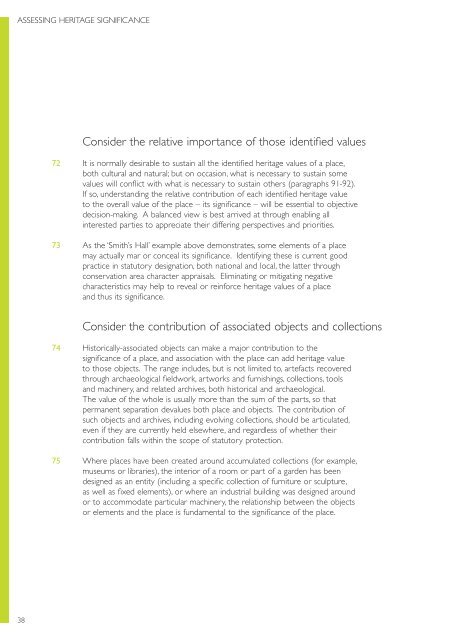Conservation Principles, Policies and Guidance - English Heritage
Conservation Principles, Policies and Guidance - English Heritage
Conservation Principles, Policies and Guidance - English Heritage
Create successful ePaper yourself
Turn your PDF publications into a flip-book with our unique Google optimized e-Paper software.
ASSESSING HERITAGE SIGNIFICANCE<br />
38<br />
Consider the relative importance of those identified values<br />
72 It is normally desirable to sustain all the identified heritage values of a place,<br />
both cultural <strong>and</strong> natural; but on occasion, what is necessary to sustain some<br />
values will conflict with what is necessary to sustain others (paragraphs 91-92).<br />
If so, underst<strong>and</strong>ing the relative contribution of each identified heritage value<br />
to the overall value of the place – its significance – will be essential to objective<br />
decision-making. A balanced view is best arrived at through enabling all<br />
interested parties to appreciate their differing perspectives <strong>and</strong> priorities.<br />
73 As the ‘Smith’s Hall’ example above demonstrates, some elements of a place<br />
may actually mar or conceal its significance. Identifying these is current good<br />
practice in statutory designation, both national <strong>and</strong> local, the latter through<br />
conservation area character appraisals. Eliminating or mitigating negative<br />
characteristics may help to reveal or reinforce heritage values of a place<br />
<strong>and</strong> thus its significance.<br />
Consider the contribution of associated objects <strong>and</strong> collections<br />
74 Historically-associated objects can make a major contribution to the<br />
significance of a place, <strong>and</strong> association with the place can add heritage value<br />
to those objects. The range includes, but is not limited to, artefacts recovered<br />
through archaeological fieldwork, artworks <strong>and</strong> furnishings, collections, tools<br />
<strong>and</strong> machinery, <strong>and</strong> related archives, both historical <strong>and</strong> archaeological.<br />
The value of the whole is usually more than the sum of the parts, so that<br />
permanent separation devalues both place <strong>and</strong> objects. The contribution of<br />
such objects <strong>and</strong> archives, including evolving collections, should be articulated,<br />
even if they are currently held elsewhere, <strong>and</strong> regardless of whether their<br />
contribution falls within the scope of statutory protection.<br />
75 Where places have been created around accumulated collections (for example,<br />
museums or libraries), the interior of a room or part of a garden has been<br />
designed as an entity (including a specific collection of furniture or sculpture,<br />
as well as fixed elements), or where an industrial building was designed around<br />
or to accommodate particular machinery, the relationship between the objects<br />
or elements <strong>and</strong> the place is fundamental to the significance of the place.

















